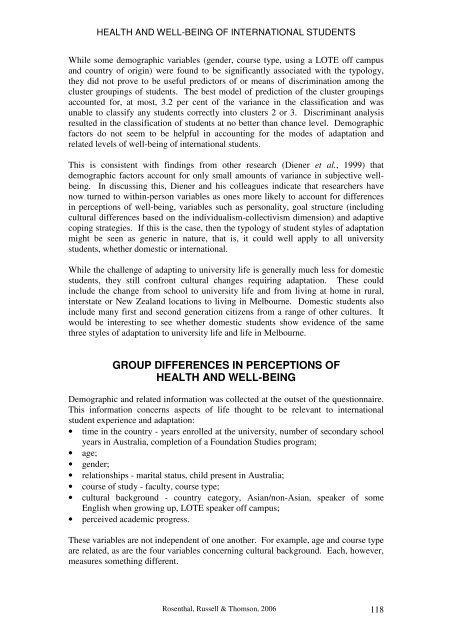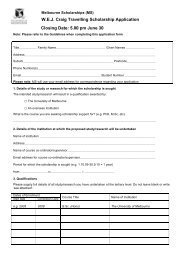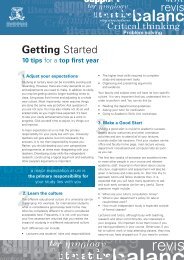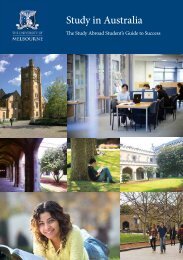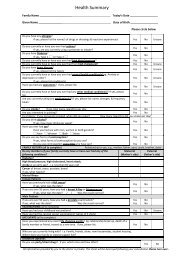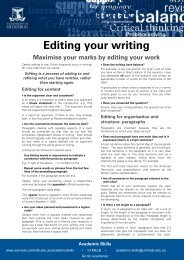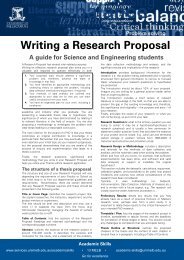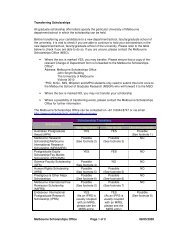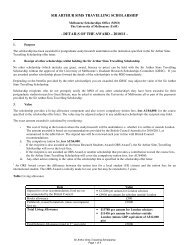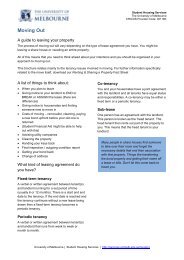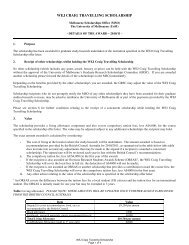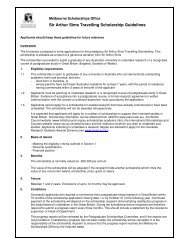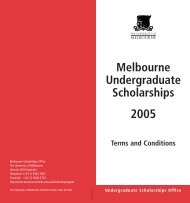HEALTH AND WELL-BEING OF INTERNATIONAL STUDENTSThe second form <strong>of</strong> maladaptive coping is seen in a small minority <strong>of</strong> students, about7 per cent <strong>of</strong> the present sample. These students also show evidence <strong>of</strong> emotionaldistress. <strong>Student</strong>s exhibiting the third style <strong>of</strong> adaptation, the distressed and risktakingstyle, like their counterparts whose approach is unconnected and stressed,<strong>experience</strong> above-average levels <strong>of</strong> cultural stress, depression, anxiety and generalstress, though the patterning <strong>of</strong> scale scores in these dimensions is different. Thirdmode students are much more depressed and anxious, while being less culturallystressed. The most obvious difference between the second and third modes <strong>of</strong>adaptation, however, is the distress expressed by third mode students through thepattern <strong>of</strong> their behaviours: high levels <strong>of</strong> potentially damaging involvement in drugs,alcohol, smoking, gambling, risky sexual activity and self-harm. This is morestrongly a male mode <strong>of</strong> adaptation than a female one, a finding that is well supportedin the literature (Barnes, Welte, H<strong>of</strong>fmann, & Dintcheff, 2005; Hardoon, Gupta, &Derevensky, 2004; Stinchfield, 2000; Stinchfield & Winters, 1998).There is considerable evidence in the research literature <strong>of</strong> the co-occurrence <strong>of</strong> theserisky, health-related behaviours (Barnes et al., 2005; Desiderato & Crawford, 1995;Griffiths & Sutherland, 1998; Shaffer & Korn, 2002; Stewart & Kushner, 2005;Stinchfield, 2000; Vitaro, Bredgen, Ladouceur, & Tremblay, 2001; Wagner, 2001),with many studies also pointing to common risk factors, predictors and correlates.For example, there is evidence supporting the involvement <strong>of</strong> depression and anxiety(Holahan, Cronkite & Randall, 2001; Nathan, 2005; Shaffer & Korn, 2002; Wagner,2001), as well as the use <strong>of</strong> avoidance and denial strategies for coping (Nower,Derevensky, & Gupta, 2004).Four types <strong>of</strong> motivation for drinking have been validated by Cooper in her fourfactormodel (Cooper, 1994) - social, coping, enhancement and conformity. Drinkingto cope has been shown to be associated with elevated levels <strong>of</strong> negative affect,particularly depression and anxiety, the placing <strong>of</strong> greater reliance on ineffectualforms <strong>of</strong> emotion-focussed coping strategies (such as avoidance and denial) and thebelief that alcohol can reduce tension and anxiety (Cooper, Frone, Russell, & Mudar,1995; Holahan et al., 2001). These avoidant and denial-oriented coping strategiescontrast with the active task-oriented coping <strong>of</strong> those not involved in these and relatedbehaviours (Nower et al., 2004). In the present study, students with a distressed andrisk-taking mode <strong>of</strong> adaptation appear to be using such maladaptive coping strategies.These strategies do not bring them a positive sense <strong>of</strong> well-being in the domains <strong>of</strong>life investigated.Some validation <strong>of</strong> the interpretation <strong>of</strong> the typology is provided by the predicteddifferences that were found in students’ satisfaction, psychological states andbehaviour in different domains, based on their style <strong>of</strong> adaptation: perceived need andactual use <strong>of</strong> university health and counselling services, social mixing, belonging toorganisations, satisfaction with living arrangements, level <strong>of</strong> self-esteem, and level <strong>of</strong>stress associated with the need to do well academically for the sake <strong>of</strong> the family.While this typology is a convenient generalisation about sets <strong>of</strong> tendencies,encompassing considerable variation within each style, and does not allow predictionfrom the group to the individual level, the generalisation it <strong>of</strong>fers is neverthelessuseful for those seeking to maximise the quality <strong>of</strong> students’ satisfaction andachievement in adapting to university life in Australia.Rosenthal, Russell & Thomson, 2006 117
HEALTH AND WELL-BEING OF INTERNATIONAL STUDENTSWhile some demographic variables (gender, course type, using a LOTE <strong>of</strong>f campusand country <strong>of</strong> origin) were found to be significantly associated with the typology,they did not prove to be useful predictors <strong>of</strong> or means <strong>of</strong> discrimination among thecluster groupings <strong>of</strong> students. The best model <strong>of</strong> prediction <strong>of</strong> the cluster groupingsaccounted for, at most, 3.2 per cent <strong>of</strong> the variance in the classification and wasunable to classify any students correctly into clusters 2 or 3. Discriminant analysisresulted in the classification <strong>of</strong> students at no better than chance level. Demographicfactors do not seem to be helpful in accounting for the modes <strong>of</strong> adaptation andrelated levels <strong>of</strong> well-being <strong>of</strong> international students.This is consistent with findings from other research (Diener et al., 1999) thatdemographic factors account for only small amounts <strong>of</strong> variance in subjective wellbeing.In discussing this, Diener and his colleagues indicate that researchers havenow turned to within-person variables as ones more likely to account for differencesin perceptions <strong>of</strong> well-being, variables such as personality, goal structure (includingcultural differences based on the individualism-collectivism dimension) and adaptivecoping strategies. If this is the case, then the typology <strong>of</strong> student styles <strong>of</strong> adaptationmight be seen as generic in nature, that is, it could well apply to all universitystudents, whether domestic or international.While the challenge <strong>of</strong> adapting to university life is generally much less for domesticstudents, they still confront cultural changes requiring adaptation. These couldinclude the change from school to university life and from living at home in rural,interstate or New Zealand locations to living in <strong>Melbourne</strong>. Domestic students alsoinclude many first and second generation citizens from a range <strong>of</strong> other cultures. Itwould be interesting to see whether domestic students show evidence <strong>of</strong> the samethree styles <strong>of</strong> adaptation to university life and life in <strong>Melbourne</strong>.GROUP DIFFERENCES IN PERCEPTIONS OFHEALTH AND WELL-BEINGDemographic and related information was collected at the outset <strong>of</strong> the questionnaire.This information concerns aspects <strong>of</strong> life thought to be relevant to internationalstudent <strong>experience</strong> and adaptation:• time in the country - years enrolled at the university, number <strong>of</strong> secondary schoolyears in Australia, completion <strong>of</strong> a Foundation Studies program;• age;• gender;• relationships - marital status, child present in Australia;• course <strong>of</strong> study - faculty, course type;• cultural background - country category, Asian/non-Asian, speaker <strong>of</strong> someEnglish when <strong>growing</strong> up, LOTE speaker <strong>of</strong>f campus;• perceived academic progress.These variables are not independent <strong>of</strong> one another. For example, age and course typeare related, as are the four variables concerning cultural background. Each, however,measures something different.Rosenthal, Russell & Thomson, 2006 118


